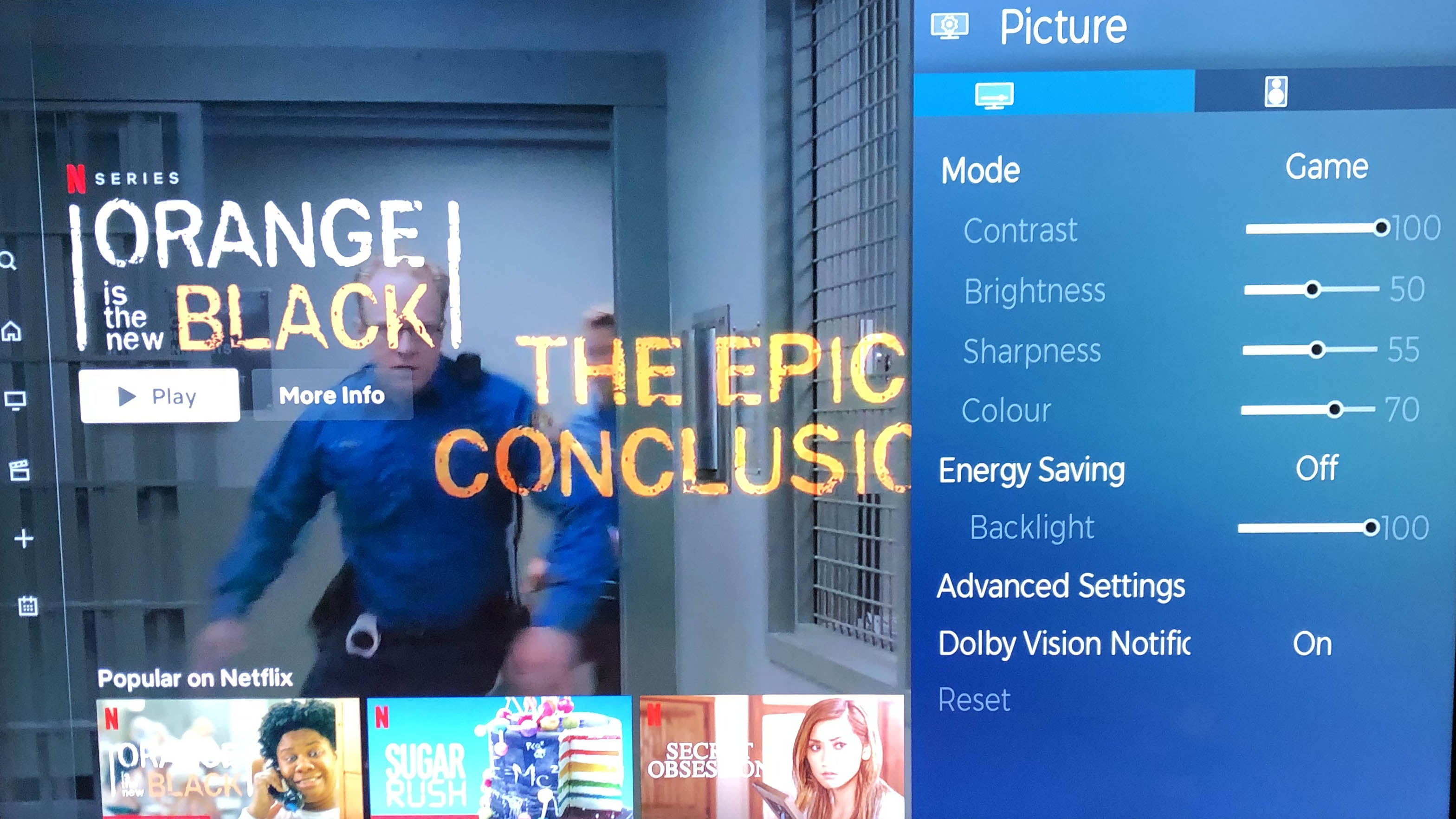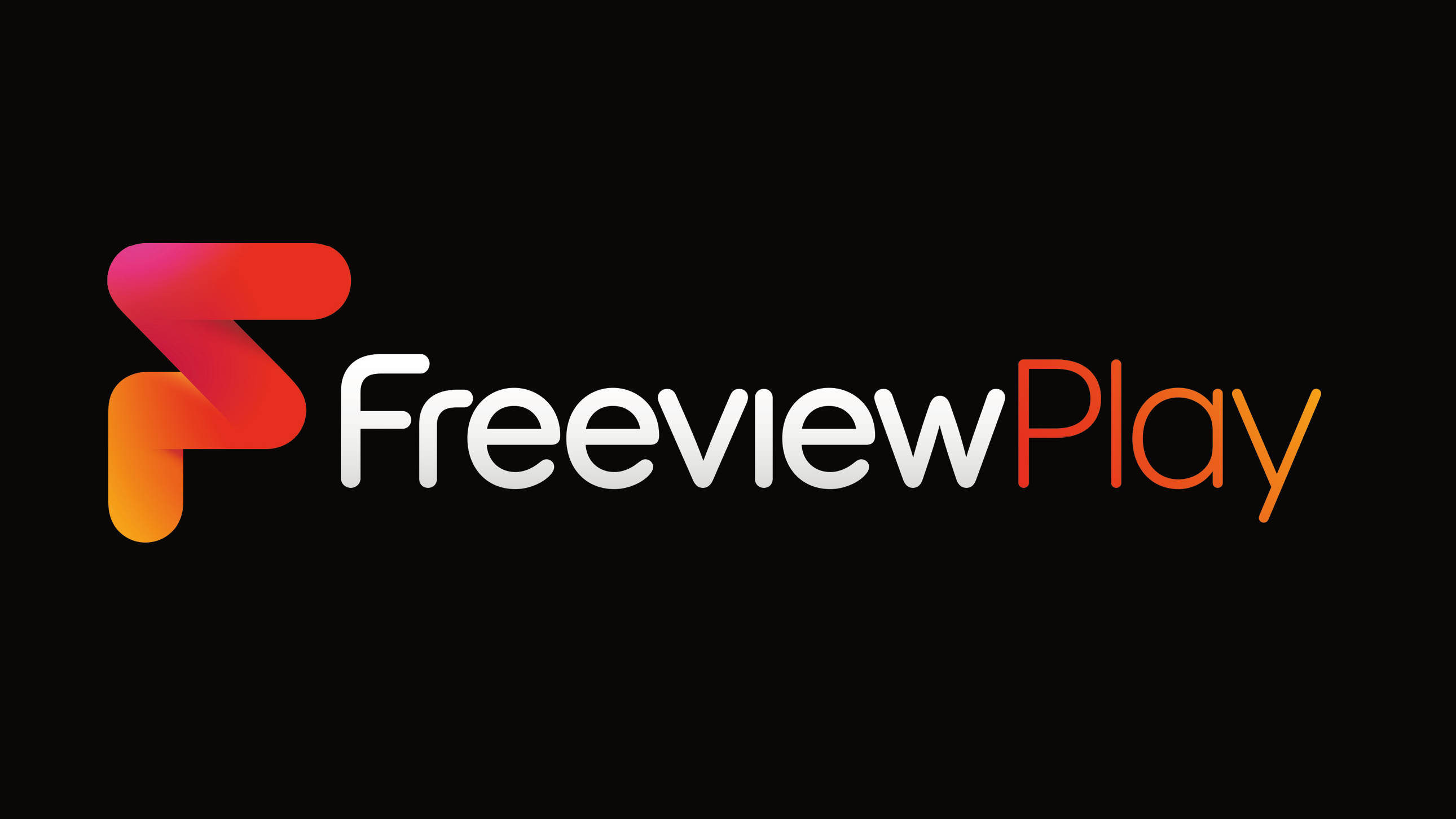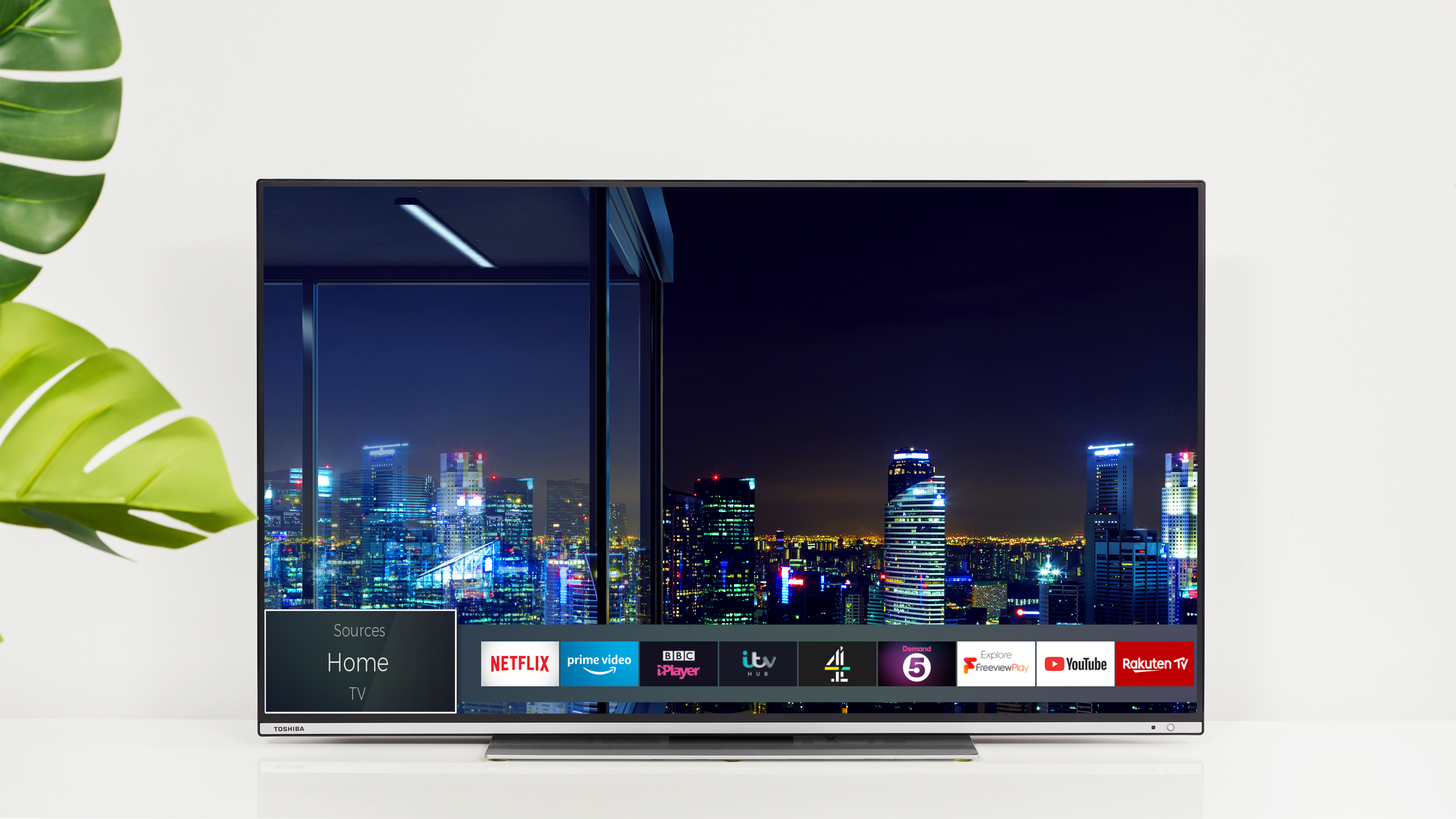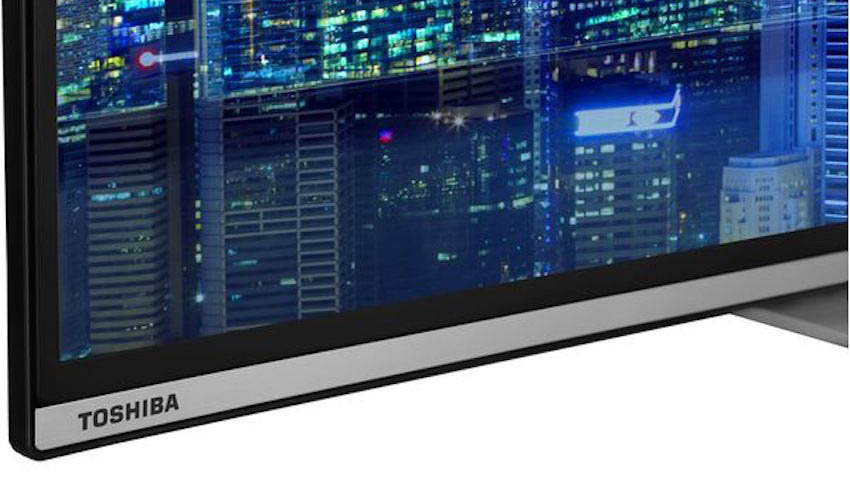TechRadar Verdict
Inevitably the Toshiba 55UL7A63DB’s aggressive price comes with some performance strings attached. But its flaws are pretty standard for the budget world, and it has just enough tricks up its sleeve – including Dolby Vision support and a well-stocked set of smart apps – to make it worth considering, if £479 is as far as your budget can stretch.
Pros
- +
Good value
- +
Dolby Vision support
- +
Decent smart system
- +
Attractively designed
Cons
- -
HDR pictures lack brightness
- -
Needs care with setup
- -
Sluggish menus
- -
Backlight clouding
Why you can trust TechRadar
You don’t have to look hard to figure out the best feature of the Toshiba 55UL7A63DB: the price. You are getting, after all, a 55-inch TV with a native 4K resolution, high dynamic range support, and a smart TV system for just £479 – despite the UL7A model being the premium sibling to the even cheaper Toshiba UL5A. But is Toshiba just ‘ticking boxes’ with these features, or are they done well enough to justify it?
- After cheap TVs? The Black Friday TV deals are on their way
Design
The Toshiba UL7A, available in both 49-inch and 55-inch sizes, doesn’t look like a budget TV. For starters, it’s remarkably slim across the majority of its rear for a TV that uses a direct LED lighting system – where the LEDs sit directly behind the screen rather than around its edges. The cool black finish of most of its chassis is offset attractively, too, by a silver metallic strip running along underneath the screen.
The finish is plush enough to give at least the impression of good build quality. In truth, while fixing the TV onto its minimalist, surprisingly heavy duty metal stand, we couldn’t help but notice that the UL7A’s main chassis is actually pretty lightweight. Provided you keep friends and family at a safe decent distance from it, though, they’ll likely never guess it cost you under £500.

The Toshiba UL7A’s connections are healthily numerous for such an aggressively priced TV. They include four HDMIs – as many as you’ll find on even the most expensive rival TV – alongside a pair of USBs that support both recording from the TV’s Freeview HD tuner to USB hard drives, or playback of a decent selection of file formats.
There are a trio of ‘old school’ connections, too, in the shape of a VGA PC port, a composite video input, and a component video input. It’s hard to picture many people using these sockets in an era where even bog-standard PCs carry HDMI (or at least DVI output). But as their presence doesn’t seem to be costing you anything, I guess there’s no harm in them being there – as long as they’re not indicative of some old-school tech inside the TV, too.
Unexpectedly, the UL7A ships with two remote controls. As usual with TVs that provide two handsets, one is a large one packed with buttons, while the other is a smaller, more minimal effort.
Both are actually quite comfortable to hold and easy to use, and both carry plenty of buttons providing direct access to different apps and sources, such as Netflix and YouTube. Curiously, while the big remote has a direct access button for Amazon Prime, this turns into a Rakuten TV button on the smaller handset.
Sign up for breaking news, reviews, opinion, top tech deals, and more.
Design TL;DR: The UL7A looks sharper from a typical viewing distance than you might expect with such a cheap TV.
Smart TV

The UL7A boasts a surprisingly attractive and helpful smart interface. It eschews the clunky, dated full-screen home page you get with most budget TVs – assuming a budget TV even has any smart features – in favour of a row of app icons superimposed over the bottom edge of the picture.
This tidy, economical approach means you can keep watching TV while you browse, and has clearly taken a leaf out of LG’s webOS playbook – never a bad thing.
Also impressive is the way the Toshiba UL7A lets you access tuner and TV settings simply by scrolling down from the home page apps row. It’s nice to see settings integrated so well into a smart interface, rather than existing in an entirely separate menu area.
The app icons are bright and clean, and there are more apps available than I’d expected to see at this price point – even if many of them are of minimal interest to UK users.
The ones that count are Netflix, Amazon, YouTube, Rakuten and the Freeview Play app that plays host to all of the UK’s main terrestrial broadcaster catch-up services.

It’s a relief at this price point, too, to find the UL7A supporting 4K and HDR (including Dolby Vision) playback on the Netflix, Amazon and YouTube apps.
While Toshiba's UL7A gets many things about its smart features right, though, it does fall short in one area. Its menus tend to run aggravatingly slowly at times, suggesting that Toshiba – a brand now owned by Turkish manufacturer Vestel in Europe – hasn’t equipped the set with enough processing power to match its smart system’s ambitions.
Smart features TL;DR: The UL7A carries a better looking and more comprehensive smart system than you would expect to see on such a cheap TV. It’s just a shame the operating system is so sluggish.
HD/SDR Performance
As with most budget HDR-capable TVs, the Toshiba UL7A is actually at its best – or certainly its most comfortable – with SDR content.
Colours, for instance, tend to look impressively natural and realistic by budget TV standards – even when it comes to tricky dark-scene skin tones. Colour blends are portrayed without banding or blockiness, helping objects and faces in SDR pictures look likably solid and authentic.
Contrast is a cut above the budget norm too, putting credible black levels right alongside decently punchy peak whites and bright colours.

While the backlighting gets caught out by HDR (as we’ll see in the next section), with SDR dark scenes tend to appear without much in the way of backlight clouding and inconsistency.
The UL7A’s upscaling of sub-4K sources is pretty good for such an affordable TV too. It struggles a little with faces, leaving them looking a little mannequin-like. Otherwise, though, its upscaled pictures look decently crisp and detailed, as well as appearing reasonably free of source noise.
The sharpness of the UL7A’s HD pictures is enhanced by some surprisingly good motion handling. It’s not perfect, of course, with some judder being a touch too pronounced – while turning on the set’s Tru Flow motion processing can cause a little fluttering over very detailed, fast moving parts of the picture. Neither of these issues, though, is nearly as bad as the sort of motion issues usually found on such affordable 4K TVs.
HD/SDR Performance TL;DR: The UL7A is a comfortably above-par performer with the ‘legacy’ content most of us still actually spend the majority of our time watching.
4K/HDR Performance

Getting support for the premium Dolby Vision HDR format on a £479 55-inch 4K TV seems like a pretty sweet deal. After all, it’s typically the preserve of the sort of high-end TVs most of us can’t dream of affording.
Actually, though, Dolby Vision typically makes the most difference on relatively affordable TVs (it’s quite common on budget sets in the US). By providing extra scene by scene picture data in the HDR stream, Dolby Vision takes a huge burden off a TV’s own HDR picture processors. And, naturally, budget TVs tend to have less powerful picture processors than expensive ones.
The Toshiba UL7A perfectly underlines this often misunderstood point about Dolby Vision, delivering much better results with Dolby Vision content than plain HDR10 content. Contrast looks significantly better, for instance, with a markedly bigger ‘gap’ between the brightest and darkest parts of Dolby Vision images.
The improvement Dolby Vision makes to colours is maybe even more pronounced. As we’ll discuss later, the UL7A struggles a bit with colour when playing normal HDR10 pictures. But with Dolby Vision colours look more precise, more dynamic, and more natural – which is, of course, what HDR (together with the wide colour gamuts that almost always accompany it) is all about.
Dolby Vision pictures also tend to look slightly brighter – or at least enjoy brighter highlights – on the UL7A than normal HDR10 pictures. But this also brings us to the UL7A’s biggest weakness as an HDR television: its lack of brightness.
I measured its light output on a white HDR window occupying 10% of its screen at just under 300 nits. Some high-end LCD HDR TVs now peak at well over 2000 nits, while the latest OLEDs are creeping ever closer to 1,000 nits. While good HDR isn’t only about brightness, there’s no getting round the fact that it matters – and 300 nits isn’t really enough to make HDR look convincing.

Trying to run the TV at its brightest levels will also see the lightest highlights of HDR10 pictures clip (lose detail and shading) quite badly, along with inconsistent blotches of light despite a direct lighting system. This means you have to rein the brightness in if you don’t want parts of HDR10 pictures to start looking like they’ve had glowing holes ripped out of them.
On the other hand, if you turn the brightness down too much with HDR10 footage, shadowy details can start to disappear in dark areas, while colours in dark scenes can start to slide off key.
This means there’s a fairly slender sweet spot in the UL7A’s settings for balancing the opposite demands of colour, clipping, contrast and HDR brightness. In fact, there isn’t any setting or combination of settings that gives you a perfect balance between all of HDR’s conflicting demands.
The UL7A is on much safer ground with its 4K performance. It plays native 4K sources with more sharpness and detail than I’d necessarily expect to see at this level of the market. A situation bolstered by the screen’s freedom from the blurring that so commonly shows up on budget 4K TVs.
4K/HDR Performance TL;DR: While the UL7A is a pretty accomplished 4K performer, its issues with HDR are enough to make me think you might be better avoiding HDR sources where possible – especially if those HDR sources aren’t available in Dolby Vision.
Sound

Intriguingly, Toshiba has joined forces with acclaimed audio brand Onkyo when designing the UL7A’s speaker system. For the most part, though, I wouldn’t say this collaboration has yielded any particularly brilliant audio fruit.
To start with, the sound struggles to escape from the speakers with the attack, velocity and dynamism we now look to hear from good built-in TV sound systems. This leaves even slightly dense sound sources feeling a little boxed-in and flat, rather than expansive and rich.
There’s a slightly thuddy quality to bass sounds, too, while high pitched sounds can sometimes sound a bit too shrill for comfort.
The Toshiba UL7A isn’t entirely without audio charms, though. The speakers are sturdy enough not to succumb to distortions or drop outs even when pushed almost as loud as they can go. Unexpected Dolby Audio modes also help, adding clarity to vocals and making the sound appear more expansive.
Sound TL;DR: While the audio doesn’t match our expectations for Onkyo’s collaboration, the UL7A’s sound is at least functional. Soe clever Dolby Audio modes help too.
Other panels to consider

It’s not often TVs as affordable as the Toshiba UL7A come our way, so it’s tricky to confidently pick out major rivals. Especially as the UL7A isn’t on sale in the US, where it might have been considered against, perhaps, the latest 55-inch TCL 6-series set.
LG has a number of cheap 4K LCD models in its range that you could think about instead, though these will invariably use an IPS LCD panel rather than the VA one inside the UL7A, resulting in less contrast (but a slightly wider viewing angle).
Philips is also starting to do some good budget LCD TVs. Its just-released 55UL87A63DB, for instance, looks set to provide superior contrast, Philips’ Ambilight technology, and support for both HDR10+ and Dolby Vision for £70 more.
Verdict
The Toshiba UL7A is in some ways a slightly frustrating TV. For every plus point there seems to be a more or less equal downside. Its lack of brightness with HDR, in particular, means it’s best treated as a 4K SDR TV, if your sources let you turn their HDR support off.
The UL7A is well designed, though, and delivers a surprisingly well-populated smart system, all while handling SDR and Dolby Vision pictures well enough to justify its £479 price.
- After something more compact? See our best 40-inch TVs guide

John has been writing about home entertainment technology for more than two decades - an especially impressive feat considering he still claims to only be 35 years old (yeah, right). In that time he’s reviewed hundreds if not thousands of TVs, projectors and speakers, and spent frankly far too long sitting by himself in a dark room.